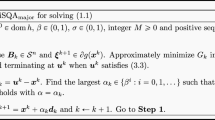Abstract
In [6], a polynomial algorithm based on successive piecewise linear approximation was described. The algorithm is polynomial for constrained nonlinear (convex or concave) optimization, when the constraint matrix has a polynomial size subdeterminant. We propose here a practical adaptation of that algorithm with the idea of successive piecewise linear approximation of the objective on refined grids, and the testing of the gap between lower and upper bounds. The implementation uses the primal affine interior point method at each approximation step. We develop special features to speed up each step and to evaluate the gap. Empirical study of problems of size up to 198 variables and 99 constraints indicates that the procedure is very efficient and all problems tested were terminated after 171 interior point iterations. The procedure used in the implementation is proved to converge when the objective is strongly convex.
Similar content being viewed by others
References
E.R. Barnes, A variation on Karmarkar's algorithm for solving linear programming problems, Manuscript, IBM T.J. Watson Research Center, Yorktown Heights, NY (1985).
M.S. Bazaraa and C.M. Shetty,Nonlinear Programming: Theory and Algorithms (Wiley, 1979).
I.I. Dikin, Iterative solution of problems of linear and quadratic programming, Sov. Math. Dokl. 8(1967)674–675.
G.B. Dantzig,Linear Programming and Extensions (Princeton University Press, 1963).
R. Fourer, Simplex algorithm for piecewise-linear programming I: Derivation and proof, Math. Progr. 33(1985)204–233.
D.S. Hochbaum and J.G. Shanthikumar, Convex separable optimization is not much harder than linear optimization, J. ACM 37(1990)843–862.
R.R. Meyer, Computational aspects of two-segment separable programming, Math. Progr. 26(1983)21–39.
A. Premoli, Piecewise linear programming: The compact (CPLP) algorithm, Math. Progr. 36(1986)210–227.
R.T. Rockafellar,Network Flows and Monotropic Optimization (Wiley, 1984).
R.J. Vanderbei, M.S. Meketon and B.A. Freedman, A modification of Karmarkar's linear programming algorithm, Algorithmica 1(1986)395–407.
P. Wolfe, Methods of nonlinear programming, in:Recent Advances in Mathematical Programming, ed. R.L. Graves and P. Wolfe (1963).
P. Wolfe, Convergence theory in nonlinear programming, in:Integer and Nonlinear Programming, ed. J. Abadie (North-Holland, 1970).
Author information
Authors and Affiliations
Additional information
Supported in part by the Office of Naval Research under Grant No. N00014-88-K-0377 and Grant No. ONR N00014-91-J-1241.
Rights and permissions
About this article
Cite this article
Hochbaum, D.S., Seshadri, S. The empirical performance of a polynomial algorithm for constrained nonlinear optimization. Ann Oper Res 43, 229–248 (1993). https://doi.org/10.1007/BF02025453
Issue Date:
DOI: https://doi.org/10.1007/BF02025453




